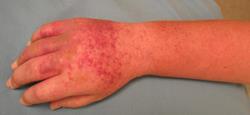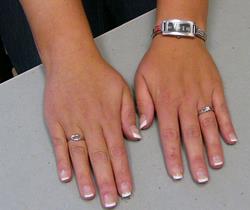Diseases & Conditions
Complex Regional Pain Syndrome (Reflex Sympathetic Dystrophy)
Complex regional pain syndrome (CRPS) is a condition resulting in intense burning pain, stiffness, swelling, and discoloration that most often affects the hand. Arms, legs, and feet can also be affected by CRPS.
This condition was previously known as reflex sympathetic dystrophy, Sudeck's atrophy, shoulder-hand syndrome, or causalgia.
Description
There are two types of CRPS:
- Type 1 does not involve a direct injury to a nerve and typically occurs after an illness or other injury.
- Type 2 follows a distinct nerve injury.
Although the triggers vary, both types of CRPS are characterized by the same symptoms and the same three stages of disease.
Stage I: Acute
- Stage I may last up to 3 months.
- Burning pain and increased sensitivity to touch are the most common early symptoms of CRPS. This pain is different — more constant and longer lasting — than would be expected with a given injury.
- Swelling and joint stiffness usually follow, along with increased warmth and redness in the affected limb.
- There may be faster-than-normal nail and hair growth and excessive sweating.
Stage II: Dystrophic
- Stage II can last 3 to 12 months.
- Swelling is more constant and skin wrinkles disappear.
- Skin temperature becomes cooler.
- Fingernails become brittle.
- Pain is more widespread.
- Stiffness increases.
- The affected area becomes more sensitive to touch.
Stage III: Atrophic
- Stage III occurs after 1 year.
- The skin of the affected area becomes pale, dry, tightly stretched, and shiny.
- The area is stiff and there is less hope of getting motion back.
- Pain may decrease.
- The condition may spread to other areas of the body.
Cause
Although the two types of CRPS can be tied to injury or illness, the exact cause of CRPS is unknown.
One theory is that a short circuit in the nervous system is responsible. This short circuit causes overactivity of the sympathetic (unconscious) nervous system which affects blood flow and sweat glands in the affected area.
Symptoms most commonly occur after injury or surgery. Other causes include:
- Pressure on a nerve
- Infection
- Cancer
- Neck problems
- Stroke
- Heart attack
Doctor Examination
After discussing your medical history and symptoms, your doctor will carefully examine your hand or affected limb.
People with CRPS are unusually protective of the involved limb. Even a light touch may evoke expressions of severe pain.
Tests
There is no single test that can make the diagnosis of CRPS. Some imaging tests, such as X-rays, bone scans, and magnetic resonance imaging (MRI) scans can help your doctor make a firm diagnosis.
Treatment
Early diagnosis and treatment are important to prevent CRPS from progressing into the later stages.
It is also important that doctors not tell these patients that the pain is "in their heads." CRPS is a physiological condition (meaning it is related to how the body functions, not to a person's emotional or mental state). Even though it is not fully understood, CRPS is treatable.
Nonsurgical Treatment
Medications. Non-steroidal anti-inflammatory drugs (NSAIDs), oral corticosteroids, anti-depressants, blood pressure medications, anti-convulsants, and opioid analgesics (pain-relievers) are medications recommended to relieve symptoms.
Injection therapy. Injecting an anesthetic (numbing medicine) near the contributing sympathetic nerves can reduce symptoms. This is usually recommended early in the course of CRPS to avoid progression to the later stages.
Biofeedback. Increased body awareness and relaxation techniques may help with pain relief.
Therapy. Active exercise that emphasizes normal use of the affected limb is essential to permanent relief of this condition. Physical and/or occupational therapy are important in helping patients regain normal use patterns. Medications and other treatment options can reduce pain, allowing the patient to engage in active exercise.
Surgical Treatment
If nonsurgical treatment fails, there are surgical procedures that may help reduce symptoms.
Spinal cord stimulator. Tiny electrodes are implanted along your spine and deliver mild electric impulses to the affected nerves.
Pain pump implantation. A small device that delivers pain medication to the spinal cord is implanted near the abdomen.
Results from surgical procedures may be disappointing. Many patients with chronic CRPS symptoms benefit from psychological evaluation and counseling.
Recovery
Outcomes in patients with CRPS vary widely and are nearly impossible to predict. While some patients regain near normal function, others are left with permanent impairments. Thus, early recognition and treatment of CRPS is crucial.
Contributed and/or Updated by
AAOS does not endorse any treatments, procedures, products, or physicians referenced herein. This information is provided as an educational service and is not intended to serve as medical advice. Anyone seeking specific orthopaedic advice or assistance should consult his or her orthopaedic surgeon, or locate one in your area through the AAOS Find an Orthopaedist program on this website.








